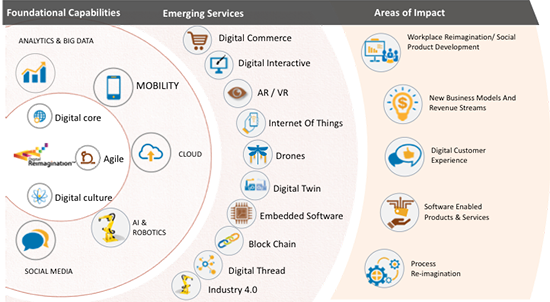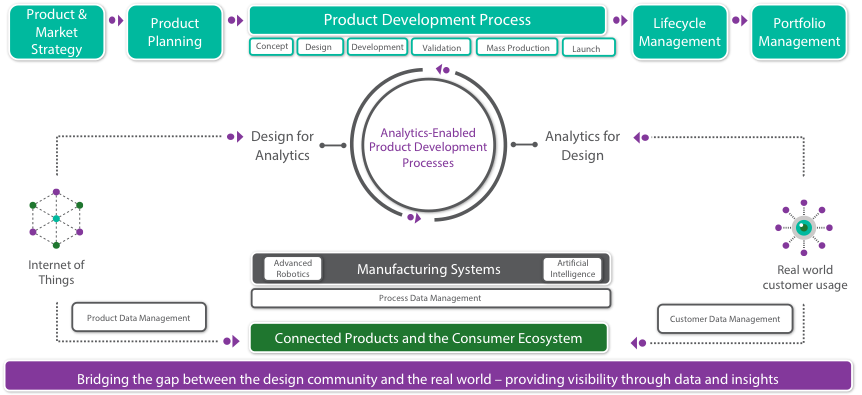Key takeaways:
- Analytics-driven insights from the data produced by connected products and processes must be fully leveraged to build a successful digital enterprise.
- TCS has helped businesses in many industries develop and execute digital enterprise transformation strategies by leveraging analytics-driven insights.
- TCS invests heavily in analytics-related R&D to ensure that the latest knowledge and tools are available for accelerating enterprise digital transformation.
- TCS has wide expertise in applying analytics at the intersection of enterprise resources and product engineering for identifying hitherto untapped value.
Journey to Analytics-Driven Insights and Decision-Making
Internet of Things (IoT) deployments are generating and capturing massive volumes of structured and unstructured data. The convergence of IoT, cloud, and big data is exposing new sources of information in businesses that should be leveraged through proactive and consistent use of analytics. Unfortunately, data alone has limited value. Significant transformation is required to extract insights that lead to enhanced innovation and improved operational efficiency. Given increasing data transmittal speeds that don't have geographical restrictions, the opportunity to leverage near real-time data is growing rapidly. When the near real-time data is brought together and analyzed with historical systems performance, behavioral metrics, demographics, and other data, powerful competitive advantage can be gained.
McKinsey Global Institute's 2011 report[1] on big data identifies five broad mechanisms that companies can leverage to transform themselves to create new value and outperform their piers: 1) creating transparency; 2) enabling experimentation to discover needs, expose variability, and improve performance; 3) segmenting populations to customize actions; 4) replacing/supporting human decision making with automated algorithms; and 5) innovating new business models, products, and services. Unfortunately, applying these mechanisms is not straightforward. That is because data insights often reside at the intersection of different elements of product lifecycle management and enterprise resource management, thereby requiring creative and robust analytics that cut across information technology domains to uncover them. Analytical tools must help businesses explore and visualize any type of data stored anywhere, to discover hidden opportunities in their IoT, cloud, and other digital investments.
Forward-thinking organizations realize that analytics must be operationalized to integrate actionable insights into systems and business processes for making decisions. Most businesses have begun with static dashboards, although some are experimenting with automated analytics built into applications, which are launched on mobile devices.
The journey of businesses through different levels of analytics maturity, i.e., descriptive, diagnostic, discovery, predictive, and prescriptive, needs the development of a certain analytics culture with consistent C-level support. A successful transformational journey depends on a well thought out strategy and implementation roadmap, which should be proven through positive return-on-investment and adoption at every stage.
Some recommendations for successfully operationalizing analytics[2] are described below:
- Tie short- and the long-term business objectives of projects meant to operationalize analytics with revenue, to ensure consistent executive support.
- Address data governance and stewardship issues upfront, to make sure that analytics-based decision-making is reliable.
- Facilitate transparency and communication of accomplishments, across the analytics lifecycle, to enable and drive persistent innovation.
- Integrate analytics models with organizational workflows, while making them interactive and customizing their front ends, to encourage adoption.
- Focus business execution around analytics by deploying analytics models within systems and applications to maximize the chances of leveraging insights.
- Continuously monitor and optimize the performance of systems that transmit data and/or convey control to increase consistency and confidence in decision-making.
- Maintain sufficient in-house data science skill to develop and guide analytics-driven insights transformation, even if outside firms are engaged to develop and deploy analytics solutions.
By leveraging analytics-driven insights and decision-making, at the intersection of different elements of product lifecycle and resource management, businesses can become more innovative by uncovering new ways of improving both their top-line revenue and bottom-line financial performance. However, many technical challenges need to be overcome before the value of analytics-driven insights can be proven and analytics investments within the enterprise can be increased. The challenges arise from the complexity of dealing with several types of analytics applied to many different types of data coming from many heterogeneous information systems and edge computing applications.
Depending upon the nature of the business and the areas of the business from where insights are sought, a wide variety of analytics may be applied, e.g., reporting, visualization, performance management, forecasting, optimization, rules engines, what-if simulations, geospatial analytics, social media analytics, text analytics. These wide-ranging analytics may operate on a wide variety of data types, e.g., structured, semi-structured, time-series, geospatial, event, app logs, social media, sensor and device output, streaming, real-time continuous, unstructured.
In CIMdata's opinion, analytics at the intersection of different engineering and business domains involves bridging business siloes and systems, and this is fraught with challenges of heterogeneity, discontinuity, and "not invented here" issues that are all particularly difficult to surmount in mature businesses. Although software solution providers offer a wealth of connectors, adapters, application programming interfaces, and software development kits to access data from multiple sources, as well as embed reports and visualizations into application user interfaces, while covering databases, cloud applications, and big data infrastructure, there are many moving parts to the complex analytics insights projects, making them susceptible to failure.
Considerable upfront assessment and thought is needed to develop a long-term strategy and a realistic roadmap for a business to transform itself into an enterprise that leverages its data efficiently for generating actionable insights, applicable in near real-time in a prescriptive and repeatable manner. In CIMdata's experience, it calls for expertise in developing and deploying a wide range of analytics tools, as well as the expertise in handling large volumes of high velocity data of a wide variety, coming from many different sources. In other words, a meaningful strategy and a realistic roadmap for analytics-driven insights requires deep expertise in analytics tools, data types, and large-scale systems integration. CIMdata believes that a piecemeal attempt at analytics-driven insights is likely to result in islands of analytics within a business, without the ability to leverage cross-discipline dependencies that could potentially lead to disruptive innovations.
TCS' Expertise in Transforming Businesses into Analytics-Driven Enterprises
CIMdata has observed that TCS's mature data analytics consulting practice can undertake projects extending from proof-of-concept demonstrators to strategic enterprise level transformations in different industries. TCS has developed a wide range of analytics tools over the past decade and applied them to generate insights at their clients' businesses in the automotive, aerospace, industrial machinery, and process industries. They have more than 1,200 consultants engaged globally with customers in the analytics space and they continue to reorient their competencies towards analytics, artificial intelligence, machine learning, data lakes, IoT, and master data management.
CIMdata is aware of TCS's heavy investments in analytics-related R&D to ensure that the latest understanding and tools are available for its clients' enterprise digital transformation. TCS has demonstrated both scale and complexity of engagements in analytics-driven insights, extending from data discovery to value realization, while covering information architecture, knowledge and collaboration, and value development. TCS also continuously develops analytics tools in its labs dedicated to research, deliverability, and usage by co-creating with its customers, and it possesses more than 250 patents related to digital technologies in this space.
Additionally, TCS has developed a variety of cross industry analytics tools with capabilities such as visual analytics, buzz measurement, artificial intelligence enabled image analytics, data quality manager, data modeler, big data enterprise architecture manager, neural automation, customer insights, information fusion, warm archival for big data, listening platform, and a network of software bots. TCS has also developed tools specific to the manufacturing industry such as industry specific key performance indicator tree, enterprise data models covering all value chain functions, role-based analytics, business cases for transformational benefits, early warning systems, customer lifetime profitability, predictive maintenance, executive alert system, sensor data analytics, etc. TCS also offers its Connected Universe Platform, an enterprise-grade, modular, and cloud agnostic Platform-as-a-Service solution that becomes the backbone of IoT-driven businesses, products, and services, in both consumer and industrial segments. In CIMdata's opinion, TCS offers a broad set of solutions to businesses of different types and sizes for cost-effectively extracting analytics-driven insights that can be used to help develop new products and services, while remaining cost-competitive.
CIMdata believes that TCS has made significant contribution to product quality and reliability by enabling analytics-driven insights in product development processes. TCS has leveraged its suite of data analytics tools in product development to help clients improve their capabilities through customer feedback analytics, social product development, self-learning systems, product performance optimization, feature mix optimization, product cost management, remote upgrades, connected prognostics, compliance analytics, recall analytics, and predictive maintenance. Figure 1 shows the current extent of TCS's impact in leveraging analytics-driven insights along with the focus of this expertise in product development.


Figure 1-TCS Analytics Expertise for Cross-Discipline Innovation and Enterprise Digital Transformation
(Courtesy of TCS)
TCS' expertise in analytics-driven consulting is wide and deep, cutting across different areas of engineering and business processes. The cases briefly described below highlight a few examples of uncovering cross-discipline influences and analytics transformational journeys that TCS has delivered for its clients.
- Built an organizational data core and insights platform for an aerospace OEM to enable a transformational journey to an insights-driven business.
- Defined next generation executive dashboard and data visualization strategy for an automotive OEM based on a recommended data discovery tool.
- Implemented a connected products program for an engine manufacturer to enable telematics data-based service advice to customers in near real-time.
- Developed an early field quality issues detection capability for an automotive OEM based on ontology applied to voice-of-customer data and sensor data for shrinking detection times.
- Deployed supplier capacity monitoring tool at an automotive OEM by integrating data from product development, supply chain, and sales, for early detection of capacity gaps.
- Recommended optimum mix of product derivatives to an automotive OEM for maximizing the profitability of stock orders.
Summary
Over the years, CIMdata has kept track of the progress of big data and analytics related to product development and enterprise resource management, which has seen considerable acceleration. In general, CIMdata has found that businesses in different industries have introduced silos of analytics that have been initiated by specific domain leads based on their interests and needs. Though such siloed analytics introductions are a good start to demonstrate proofs-of-concepts, they could become roadblocks to a systematic and required end-to-end transformation of businesses into analytics-driven digital enterprises, due to mismatches with the analytics needs of other areas of the enterprise.
CIMdata believes that two conditions necessary for successful transformation of a business into an innovative and efficient digital insights-driven enterprise are 1) a deep understanding of analytics tools development and 2) the ability to combine a variety of data from diverse systems while ensuring data quality. In addition, CIMdata believes that it is necessary to be able to strategically plan and execute the digital transformation based on realistic roadmaps from the "as-is" to the "to-be" state, while demonstrating incremental levels of adoption and value delivery.
CIMdata has a good understanding of TCS' suite of analytics tools and their systematic approach to developing new and better analytics tools as IoT, cloud, and big data technologies evolve. CIMdata also has a good understanding of TCS' business transformation expertise spread across businesses in different industries. Given these understandings, CIMdata is convinced that TCS' expertise in business transformation together with its depth in developing analytics tools based on it partnerships with many solution providers, as well as academic expertise in data science, will be able to help companies in different industries to successfully take on the transformational journey to become digital enterprises that leverage analytics-driven insights on a consistent and innovative basis.




